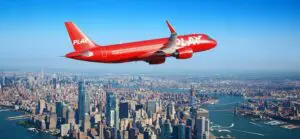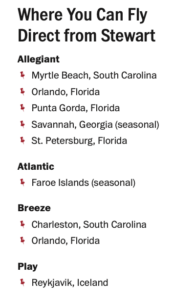I moved to Beacon in 2010, and because my job involves travel, one of the considerations in the city’s favor was the proximity to a regional airport. New York Stewart International, located across the river in New Windsor, seemed to offer convenient access to the U.S. air traffic system.
Sure enough, I found that I could connect on American Airlines — through a daily flight to Philadelphia — to many of my most common destinations, such as San Francisco, Toronto and Florida. I accepted the fact that I had only limited options of airlines and flight times and that I had to travel to the Port Authority’s other three airports (LaGuardia, JFK and Newark) for direct flights to most cities such as Austin, Texas, and for international flights to China, France and Ireland.
But then we had the pandemic, and the large carriers, Delta and American, dropped their flights to and from Stewart. Today there are only a handful of airlines operating, and the destinations are limited to a few locations in the U.S. (mostly Florida) and cheap flights to Reykjavik and the Faroe Islands.

And, of course, we are hearing the stories of near misses at airports, vacation snafus as airlines cancel thousands of flights because of too few staff and, most recently, a door “plug” blowing out in midflight. There’s more at stake than the hours wasted driving to JFK to catch a flight to San Francisco.
The situation at Stewart is not unique. The deregulation of the U.S. air travel industry in 1978 has not led to any of the claims its advocates provided in support of dismantling the regulated competition model that had served the country for 40 years, since the 1930s, in which a federal Civil Aeronautics Board allocated routes to airlines, including those to regional airports, and the prices of flights.
Ganesh Sitaraman, a law professor at Vanderbilt University and the author of Why Flying is Miserable and How to Fix It, has said that “all the things that are a problem with flying are a function of public policy choices. We decide as a country that we want children’s toys to be safe, that we want rural places to have electricity service, that we think banks should be able to function reliably. These are public policy choices to regulate or set up systems that advance goals we have as a country. When we have failures in these systems, it’s a function of getting the policies wrong. What I found in doing the research for the book is that everything about what makes flying miserable today is a function of one big public policy choice: the choice to deregulate the airlines in 1978.”
That decision led to the situation we are in now.
 “The 1980s were defined by cutthroat competition between the airlines,” Sitaraman has said. “A lot of new entrants offered no-frills service, had no unions and took on the high-volume traffic and high-traffic routes, for example. This initially meant more competition and lower prices on those routes. But the big airlines fought back and pushed out a lot of these new competitors, raised prices afterward, and consolidated into large fortress hubs like Atlanta, Dallas or Charlotte.
“The 1980s were defined by cutthroat competition between the airlines,” Sitaraman has said. “A lot of new entrants offered no-frills service, had no unions and took on the high-volume traffic and high-traffic routes, for example. This initially meant more competition and lower prices on those routes. But the big airlines fought back and pushed out a lot of these new competitors, raised prices afterward, and consolidated into large fortress hubs like Atlanta, Dallas or Charlotte.
“By the end of the decade, after dozens of bankruptcies and mergers, labor-management strife, declining service quality, congestion and lost baggage, there was a shakeout in the airlines that led to reconsolidation. The same big airlines that existed under regulation were still dominant, just without the checks of the regulated period. So, we moved from regulated oligopoly to unregulated oligopoly. Now what we have is more like monopoly capitalism, a system in which there is very little competition and few choices.”
Despite the airlines getting bailed out by the federal government during the pandemic to the tune of $50 billion, the Highlands and even many mid-sized cities such as Dubuque, Iowa, and Toledo, Ohio, have few options for air travel.
The answer is obvious: reregulate the airlines. Sitaraman told The New York Times last month how this could be done: “In big cities, limit any single carrier to 30 percent of the flights. Require the big airlines to serve smaller markets. Require ‘interlining,’ in which airlines honor one another’s tickets if one has a problem. Ban or regulate the offshoring of heavy aircraft maintenance, which is done in countries including China and El Salvador. Mandate minimum seat sizes and protect travelers from involuntary bumping.”
That sounds good to me, especially the second point, which would bring back at least a few daily flights out of Stewart to connector hubs at a reasonable rate. That should be something all Americans would welcome if Congress would come together to enact it.


I feel like there is more to this story that I’d love to see explored. I imagine with the shift in population there is more demand than before the pandemic. Besides regulation, which sounds great but highly unlikely, what would bring back the big carriers? What is stopping them? Is the local government doing anything to encourage them back? Surely this airport would take some strain off the over taxed NYC airports.
I couldn’t agree more with Stowe Boyd. He has been dealing with the airport since he moved to Beacon in 2010, but I have seen it since Stewart started passenger service: Frontier through Raleigh-Durham through Atlanta; Northwest through Detroit; American through Chicago, etc. — all better options than traveling to Kennedy or LaGuardia, not to mention the parking costs.
What percentage of people who travel over the three bridges to Long Island would have an easier, shorter, cheaper trip to Stewart? Wouldn’t it be in the best interests of the Port Authority to mandate that roughly that percentage of flights fly out of Stewart to ease the constant congestion?
When you do need to go to Kennedy, take Metro-North to Grand Central station, then the Long Island Railroad one stop to Jamaica, where you can catch the AirTrain. It’s a pretty painless trip. [via Facebook]
I fly Play to Amsterdam with a stopover in Reykjavík that is usually less than two hours. It saves me hours of driving to Newark or Kennedy, and the long-term parking is much less. Metro-North is convenient, but Stewart is still just a 15-minute drive, especially with heavy suitcases. And after an eight-hour flight back, I am home within 30 minutes of touchdown, versus more than two hours on public transit if coming into Kennedy. Stewart is underutilized. [via Facebook]
This was going on long before the pandemic. By the time I drive the nightmare to any of these airports and sit in a plane on the tarmac waiting to take off, I can drive to Albany for a reliable, on-time flight. I’d rather go to Stewart, but the Port Authority has a stranglehold on the market. Until it eases its grip, things will never change. Money talks. [via Facebook]
I miss flying from Stewart. [via Instagram]
I appreciate Boyd raising questions about the lack of activity at Stewart. But we’re missing another key point: the dangerous overcrowding at Westchester County Airport: (1) We line up in the baggage area to go through the security check-in, (2) Limited seating for waiting at the gates, (3) Pseudo gates created with orange highway cones out the “back door” for boarding, (4) Parking is so desirable you can buy parking “insurance” to try to guarantee a long-term parking spot, but often the dates are sold out, and (5) Rideshares don’t want to take you up to Beacon; I’ve had drivers cancel when they learn where I’m trying to go at 10:30 PM.
How is this not a security and safety fiasco just waiting to happen?
The back and forth over Stewart Airport initiated by Stowe Boyd’s nostalgia piece about a fantasy of re-regulating the airline industry illustrates perfectly why we never get anything done anymore. I spent 20 years in the airline industry but you don’t need me to say that regulation is never coming back, not in the way Boyd suggests. What mystifies me is that Stewart has long been identified as the best option to be New York City’s fourth regional airport to provide relief to Kennedy, LaGuardia and Newark. The Port Authority has reams of studies supporting the idea. Everyone also knows that what is required to make it happen is a reliable mass transportation link with New York City. Every study will show that such a link will make Stewart viable because it will be both accessible to the city and a lot cheaper to use. That will bring discount air service to our region. Airports bring significant employment and business creation, so Newburgh and the surrounding region will benefit directly beyond the increased access to air travel. In terms of public investment, this is as much a win/win project as you are ever likely to find. There is a passenger rail line, the Port Jervis line which goes to Hoboken, that passes not far from Stewart. There is also a rumor we are spending billions of federal dollars on infrastructure. In a bygone era, this would have been a political no-brainer, with every local politician, from mayor to representatives in… Read more »